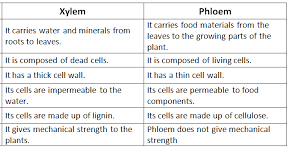Difference between Xylem and phloem
The difference between Xylem and Phloem is given here. Xylem and phloem are two terms in biology that identify different parts of a plant. To understand what differentiates them, we must know the concepts. Keep reading.

Xylem
The term xylem comes from the classical Greek xylón which means wood or firewood. It is recognized as a lignified conductive plant tissue that transports fluids from one area to another in vascular plants. Its purpose is to trans port water, mineral salts, and other nutrients from the roots to the leaves of the plants.
The transported substance is called raw sap. Together with the phloem, it forms a continuous network that extends throughout the planet. It is composed of several types of tubular cells characterized by the presence of a secondary cell wall. The conductive elements of the xylem are the tracheids, their tips resemble a hypodermic needle and are perforated. They are unicellular with a lignified secondary wall. Its primary function is conduction and the secondary one is that of support.
Phloem
Phloem comes from the Greek floiós which means bark. It is responsible for the transport of organic and inorganic nutrients produced during photosynthesis to non-photosynthetic underground parts in vascular plants. They are also known as Liberian tubes or glasses. Two types of phloem are recognized, primary and secondary. The primary phloem or stem is associated with the primary xylem and together with it builds the vascular bundles. The secondary phloem originates from the cambium that is located on the periphery of the stem or root.
suggested video:
Xylem and Phloem
Difference between Xylem and Phloem
Xylem is a lignified conductive tissue that transports liquids from one area of the plant to another. It carries nutrients and mineral salts from the roots to the leaves of the plant. The phloem is responsible for the transport of organic and inorganic nutrients produced during photosynthesis to the non-photosynthetic parts of the plant.
